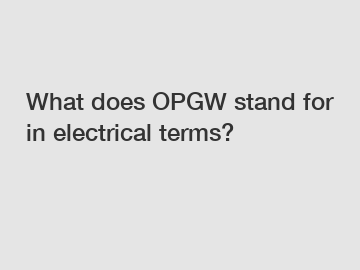What does OPGW stand for in electrical terms?
In today's fast-paced world, electricity has become an indispensable part of our lives. From powering our homes to driving industrial progress, a reliable and efficient electrical transmission system is crucial. Among the many components that make up this complex infrastructure, one that stands out is OPGW. But what does OPGW stand for in electrical terms, and how does it revolutionize power transmission? Let's uncover the secrets behind this powerful acronym.
OPGW: Optical Ground Wire.
OPGW, short for Optical Ground Wire, represents a technologically advanced addition to traditional power transmission lines. It combines the functionality of a ground wire with fiber optics, providing improved efficiency, enhanced stability, and increased data-carrying capacity.

The advent of fiber-optic technology has brought tremendous benefits to various industries. In the realm of power transmission, the integration of optical fibers within the OPGW cable helps utilities monitor, control, and protect their transmission lines more effectively.
The Role of OPGW in Power Transmission.
OPGW cables play a multifaceted role in electrical systems, aligning the requirements of power delivery and data communication. Let's explore some of the key functions of OPGW:
1. Enhanced Electrical Conduction: Along with serving as a communications pathway, OPGW functions as a metallic conductor, grounding and protecting the transmission line against lightning strikes and electrical faults. This dual functionality ensures uninterrupted power supply while minimizing the risk of damage to the system.
2. Unleashing Data Communication Potential: OPGW's incorporation of fiber optics opens up extensive data communication capabilities. By leveraging these optical fibers, utilities can monitor temperature changes, voltage levels, and line vibrations in real-time. Consequently, they gain valuable insights into the health and condition of the transmission lines, facilitating proactive maintenance and swift fault analysis.
3. Reliability and Security: With OPGW enabling seamless data transmission, utilities enjoy heightened reliability and security in their power grids. Immediate identification and isolation of faults, coupled with robust data encryption and monitoring, helps deter unauthorized access and prevents potential cyber threats.
4. Future-Proofing Electrical Infrastructure: As the demand for electricity continues to grow, OPGW enables utilities to future-proof their infrastructure. By investing in a system that supports ever-increasing data requirements, utilities can easily integrate emerging technologies like smart grids, renewable energy sources, and energy storage systems.
The Evolution and Integration of OPGW.
The history of OPGW can be traced back to the 1980s when fiber-optic technology was first introduced. Since then, the technology has evolved significantly, with installations becoming commonplace in modern power transmission projects worldwide.
The integration of OPGW requires meticulous planning, involving the accurate fusion of fiber optics, metallic strands, and protective layers. This intricate process ensures durability, high electrical conductivity, and minimal signal loss across the entire OPGW cable length.
Benefits and Advantages of OPGW.
OPGW offers a host of benefits that contribute to the seamless and efficient operation of electrical transmission systems. Some of the advantages of OPGW include:
1. Increased efficiency, reducing power losses and line impedance.
2. Cost-effective installation and maintenance, providing long-term economic benefits.
3. Immunity to electromagnetic interference, contributing to enhanced signal quality.
4. Enhanced communications infrastructure, enabling real-time monitoring and control.
5. Improved capacity for handling higher data rates, supporting future technological advancements.
Conclusion.
OPGW, short for Optical Ground Wire, represents a major leap forward in electrical transmission technology. By combining the functionalities of a ground wire and fiber-optic communication, utilities can achieve enhanced power delivery and improved communication infrastructure. Investing in OPGW not only ensures a reliable and efficient power transmission system but also paves the way for a smarter and more sustainable future.
So, the next time you encounter the term OPGW, remember its significance in revolutionizing the way we transmit, monitor, and control electrical power. OPGW is far more than just an acronym – it's a game-changer in the electrical industry.
The company is the world’s best suspension clamp for adss cable, opgw suspension clamp supplier, spiral vibration damper supplier. We are your one-stop shop for all needs. Our staff are highly-specialized and will help you find the product you need.
280
0
0

Comments
All Comments (0)